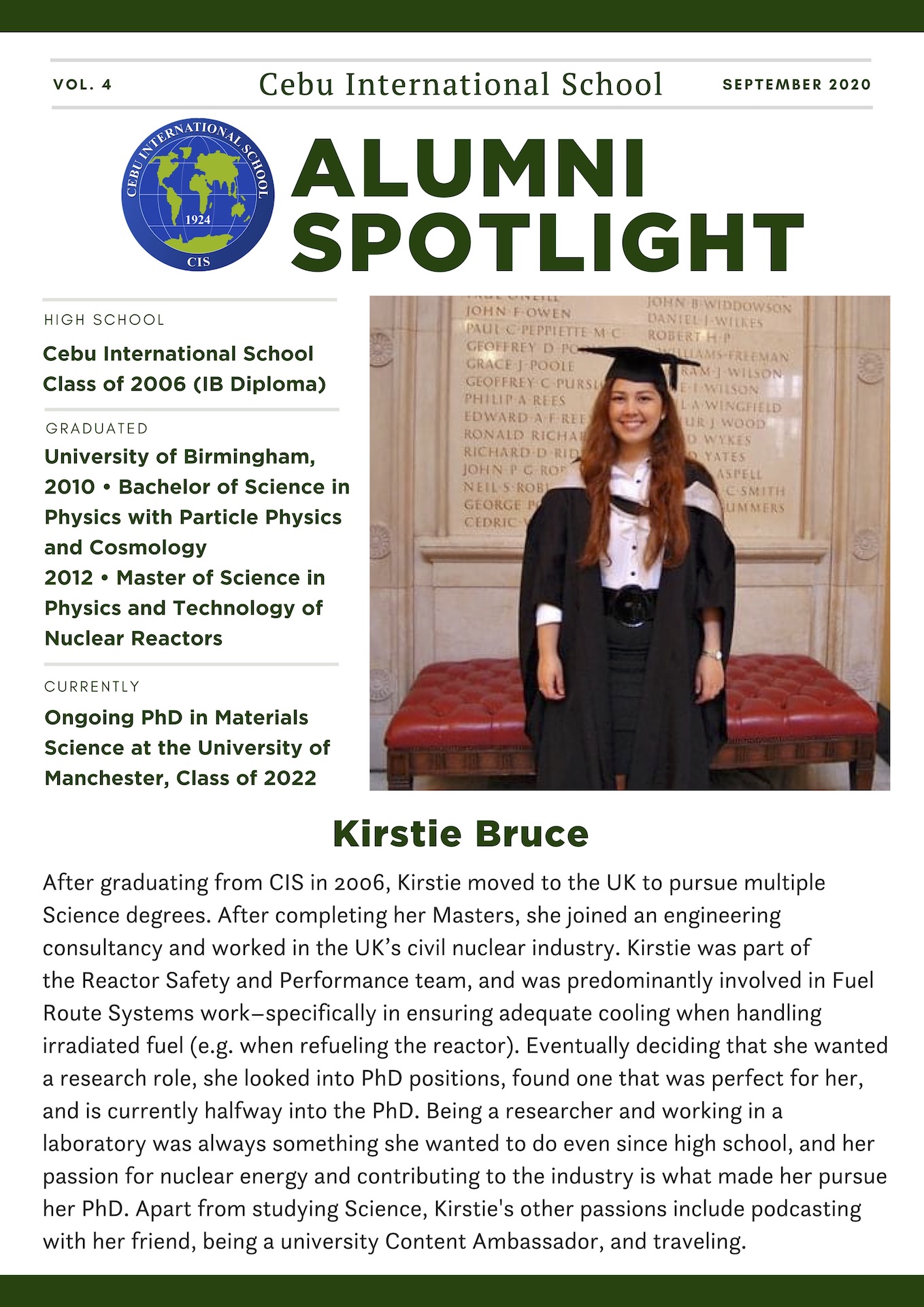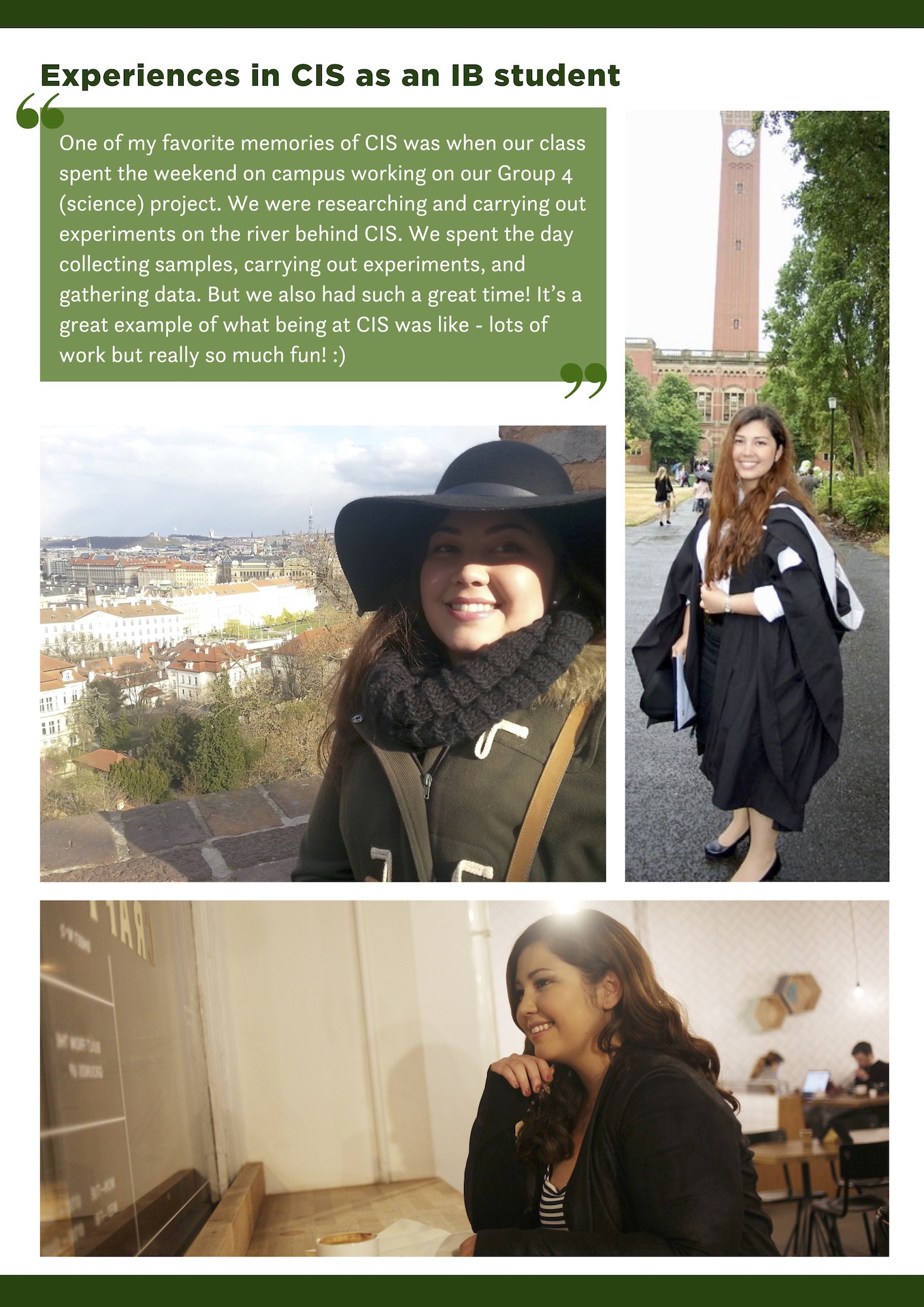
Admin News
Cebu moves to MGCQ but 20 year olds and under are still on lockdown!
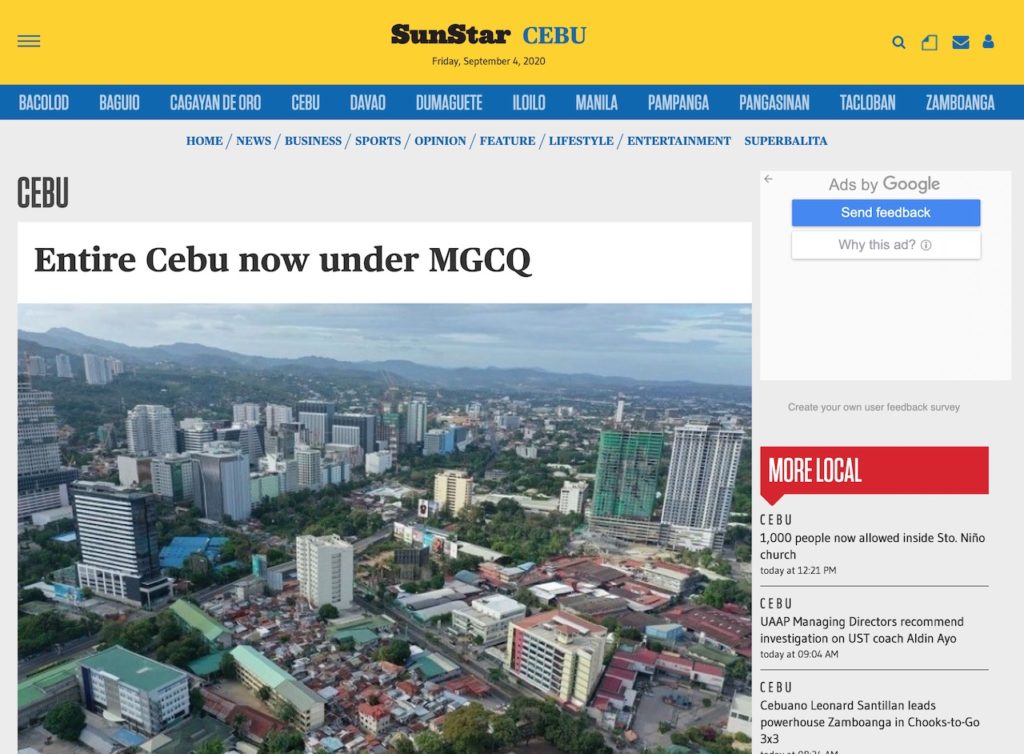 It is promising to see our risk level move down to MGCQ after 6 months of lockdown, however, for school operations, there is little change in our outlook as our students are still unable to return to school. DepEd schools restart October 5th, however, this will be via distance learning, and the indications at this stage are they will not be allowed back onto campus for some time – possibly even until a vaccine is available. We are therefore unsure when independent/private schools could be allowed back on campus. We are preparing for our return and will be seeking some specific input on the conditions we have options with from parents and students shortly. For now, we have been pleased with the positive reception we have received from our Remote Learning 3.0 program. It is positive to hear from teachers and principals that our students have settled into the the new school year with RL well, and that our learning objectives are being addressed as planned. We acknowledge RL is different to F2F learning, however, we are learning to accommodate the areas that are more challenging, and to take advantage of those that we can do better remotely!
It is promising to see our risk level move down to MGCQ after 6 months of lockdown, however, for school operations, there is little change in our outlook as our students are still unable to return to school. DepEd schools restart October 5th, however, this will be via distance learning, and the indications at this stage are they will not be allowed back onto campus for some time – possibly even until a vaccine is available. We are therefore unsure when independent/private schools could be allowed back on campus. We are preparing for our return and will be seeking some specific input on the conditions we have options with from parents and students shortly. For now, we have been pleased with the positive reception we have received from our Remote Learning 3.0 program. It is positive to hear from teachers and principals that our students have settled into the the new school year with RL well, and that our learning objectives are being addressed as planned. We acknowledge RL is different to F2F learning, however, we are learning to accommodate the areas that are more challenging, and to take advantage of those that we can do better remotely!
One way you can help is to maintain communication with your child’s teachers, and keep seeking ways to support your children in their learning engagements. Last Wednesday we hosted a virtual PTA Coffee Morning discussing how parents could support their children at home, and I will be sending home the areas we covered shortly for those who could not make it to look over. Keep an eye out for upcoming info sessions for parents. The next event we have planned for is September 17th (10am – virtual meeting), where Mr. Denton (MHS Assistant Principal-MYP) will give a session on the IB MYP. More details will be shared next week.
MYP Consultancy Visit
Last week, CIS hosted an MYP Consultancy Visit, where an IB representative virtually visited the school to look at our MYP program, documents and interview our students, teachers, admin and parents. The findings will be used to guide us as we make final preparations for our verification visit at the end of this school year, when we will be seeking authorisation to become a full MYP school (we are currently on candidate status). Once we obtain this, CIS will be the first school in the Philippines to be an IB Continuum school, offering the PYP, MYP and DP all the way through Early Years to Grade 12!
CIS Corporation meeting postponed
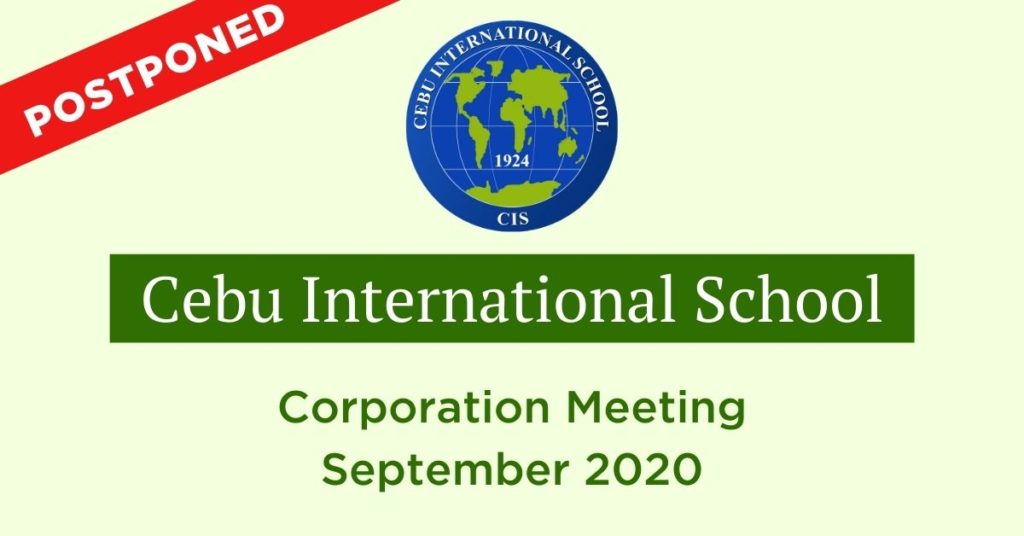 Due to COVID-19-related complications, the CIS Corporation Annual General Meeting scheduled for Sept. 15th will be postponed to a date in October yet to be decided. We will update you on the new date/time when it is confirmed.
Due to COVID-19-related complications, the CIS Corporation Annual General Meeting scheduled for Sept. 15th will be postponed to a date in October yet to be decided. We will update you on the new date/time when it is confirmed.
One of our complications is we have been unable to attract as many CIS Corporation members as we usually do. I wonder if one of the reasons why is the system is a little complicated, so I would like to try to simplify it here!
- The purpose of the Corporation is to facilitate the operations of CIS as an incorporated company, as required by the SEC.
- Our bylaws state all CIS parents and guardians are eligible for membership (the first year at CIS is as an associate member with no voting privileges).
- We usually have two meetings a year – an AGM in September and a Regular meeting in March. A written report is prepared for both meetings, and that is supplemented by a verbal report from the CEO (the Superintendent). New and renewing CIS Board members are voted in during the Sept. meeting as well.
- CIS Parents and guardians have to register to become CIS Corporation members(with a nominal fee of 200PhP). One purpose of this requirement is to ensure we can operate our meetings with interested members, as a 20% quorum of members is required (so if all parents were automatically members, we would struggle to obtain a quorum, as not all parents want to or area able to attend the meeting. By having this member system, it reduces the numbers making it more feasible to operate). It is not an exclusionary step, all parents are equally entitled to become members.
- Board members are elected using a nominating system and nominating committee to determine who would be a good addition to the 10-member Board, keeping in mind we have requirements for Philippine nationals members, and desire a representation of expat, local, and business representatives that can compliment the Board with their input. The Board speak as one voice via the Chair, and oversee governance, judiciary, strategic, and Superintendent hiring and evaluation. The Superintendent is tasked with the operational management of the school.
We are extending the CIS Corporation membership signup date, and would like to encourage parents/guardians to consider signing up to become Corporation members. Your membership supports the school by allowing for broad representation as you support the functioning of the Corporation. Please contact our Corporate Secretary, Ms. Azela Diapana <adiapana@cis.edu.ph> for sign up details.
PTA Board nominations and election
We have already received six nominations to the eight-member PTA Board, with a few more inquiries and nominations being processed, indicating we will get a good number of nominees this year! Thank you so much to those who have shown interest in contributing by agreeing to be nominated.
As it is looking like we will have more than eight nominations, we now need to go through the selection process and voting in of the new PTA Board. As outlined in the PTA Charter, we use a nominating system (like the CIS Board), the process is as follows (although note we have had to make a few adjustments to cater to the impact of the COVID-19 pandemic).
- CIS Parents nominate willing parents to the Nominating Committee via the Chair (Mr. Belda), who will collate the nominations, and confirm their willingness to serve on the PTA Board.
- The Nominating Committee considers all nominated candidates and presents a slate of eight candidates to the PTA members for voting on at our next PTA meeting (Sept 17). The selection process focuses on presenting members who represent our school’s diverse body, as well as those who can and are willing to contribute towards fulfilling the purpose the PTA Board in a united manner.
- The members of the Nominating committee will be announced shortly, as we are just confirming the last two members. (Members are drawn from the parent body who are not running for the Board, and school representatives who work with the PTA).
- Once the PTA Board has been voted in, they will vote as a Board on who will become the Officers of the Executive Committee(President/Vice President/Secretary and Treasurer).
Note this process is a little different from what has been practiced in the past few years, as the process had evolved to fit the annual needs and interests of the parents at that time. This year, we are bringing the system back to fit the PTA Charter more closely, in an attempt to encourage a wider participation at the PTA Board level. We look forward to your participation in the PTA this year as we adapt our PTA activities to fit the strange new world we are now living it!
Have a great weekend and you can look forward to another 4-day weekend next week (with Wednesday as Osmeña Day public holiday)!
Regards,
Dr. Gwyn Underwood
Superintendent
Elementary News
by Mr. Glenn Davies, Elementary School Principal
Dear Elementary Community,
Over these past two weeks, you will have received a request to connect by video conference or phone call with one of your child’s teachers. For us at CIS, connecting with you as parents is one of our priorities, as this gives you the opportunity to share your family’s Remote Learning experiences, and enables us to assess the effectiveness of our program and make adjustments to better meet individual learning needs. The feedback you have provided us with has been very positive and the suggestions you have provided for small improvements are valued.
This week I have asked Ms. Maureen Juanson, our PYP Coordinator to write a piece for the community on Social and Emotional Learning (SEL), something that is at the forefront of all our minds. We also have contributions from our Philippine Language and Culture classes.
This school year, many teachers around the globe have put in a lot of focus on Social-Emotional Learning (SEL) of students. At CIS, our teachers have also taken this on board in order to support our PYP students‘ adjustment to the new normal during these unprecedented times. SEL comes in various forms at our school, such as explicit teaching through Seesaw engagements and dialogues during homeroom synchronous lessons, Guidance and Counselling classes with our school counselor, and embedding it in the units of inquiry. But what is SEL exactly? Why is it important? Who can benefit from SEL? What is the best way to teach it? Recently, an article entitled Social-Emotional Learning: Not Just for Kids, written by Wendy Turner was published to help answer these questions. Below are some highlights that adults will find useful to support students in developing their SEL skills and competencies.
SEL, as defined by The Collaborative for Academic, Social, and Emotional  Learning (CASEL), is “how children and adults learn to understand and manage emotions, set goals, show empathy for others, establish positive relationships, and make responsible decisions” and includes five competencies. It is important for students to first access and unlock their full social-emotional self in order to attain full academic achievement. Following an SEL curriculum is just one way to develop these competencies with students but the best way to teach these skills is for adults to model these to our students every single day.
Learning (CASEL), is “how children and adults learn to understand and manage emotions, set goals, show empathy for others, establish positive relationships, and make responsible decisions” and includes five competencies. It is important for students to first access and unlock their full social-emotional self in order to attain full academic achievement. Following an SEL curriculum is just one way to develop these competencies with students but the best way to teach these skills is for adults to model these to our students every single day.
- Competency 1: Self-awareness
This focuses on setting goals, being aware of one’s strengths and weaknesses, and cultivating a growth mindset. This can be modeled by sharing goals that you’re working on, your plans to get there, and challenges that you encounter along the way.
- Competency 2: Self-management
This is our ability to manage emotions. This can be modeled by keeping our cool and recover when we lose it as we experience anger, frustration, or nervousness in everyday situations.
- Competency 3: Social awareness
This is about empathy and appreciating diversity, people, and perspectives that are different from us. This can be modeled by using caring words, noticing when others are feeling sad, hurt, upset, or frustrated and offering your help, and reaching out to others who are in need and more vulnerable.
https://www.
- Competency 4: Relationship skills
This focuses on our ability to get along and make connections with others. It includes cooperation, negotiating conflict, and communication skills. This can be modeled by trying to talk and connect with as many people as possible within your community. Make sure that the children see you engaging in positive and productive conversations with people providing you services at home, school, and others in the bigger community. Show children how to acknowledge and greet people that you interact with every day, give a compliment, and do nice things for them. Model how to become a team player and engage in collaborative activities.
-
- Competency 5: Responsible decision-making
This is our ability to make good choices as we work to solve problems and navigate our day-to-day challenges. This can be modeled by showing children how to engage in personal reflection before acting on something by asking a few questions, e.g. What am I really trying to do? Is this helpful? Is this necessary? “STOP. THINK. DECIDE.” protocol is one way to practice this with children for everyday moments and common problems.
 Source: https://www.
Source: https://www.
The first sign of children’s learning is when they repeat, imitate, or copy what they see and hear from others. Albert Bandura’s Social Learning Theory explains that children continually learn desirable and undesirable behavior through observational learning. What does this mean for us then? This means that we need to look deep within ourselves and engage in self-reflection right in front of our students. “With great intention, focus, practice, and extremely hard work, we can create better weather in our classrooms (homes) when we pursue social-emotional excellence, embracing these competencies as real, raw, complete human beings, showing our students how to do so along the way.” To effectively teach SEL to children means we just need to be authentically human, committing to doing better, and sharing our work along the way.
Remote Learning on Seesaw
This week, our EY 2/3 and KG/Grade 1 learners began to explore Filipino words through songs. The students introduce themselves by saying “ Ako ay si (name)”, identified body parts, and counted objects from 1 to 5. During our synchronous classes, students played games using Filipino Language. We played “ Simon says…,” “ Spin the Wheel”, and “Bring me Game”.

During our synchronous calls, Our young learners have engaged in the game spin the wheel. The wheel has 8 colors and each color has the corresponding action that has something to do with their body parts. We also sang our famous Filipino songs for children.
The virtual classroom was designed to promote agency, by providing students with the choice to explore which center they would like to visit in their own time. The PL&C virtual classroom is a platform where students can access the different learning centers, and each learning center has active links.
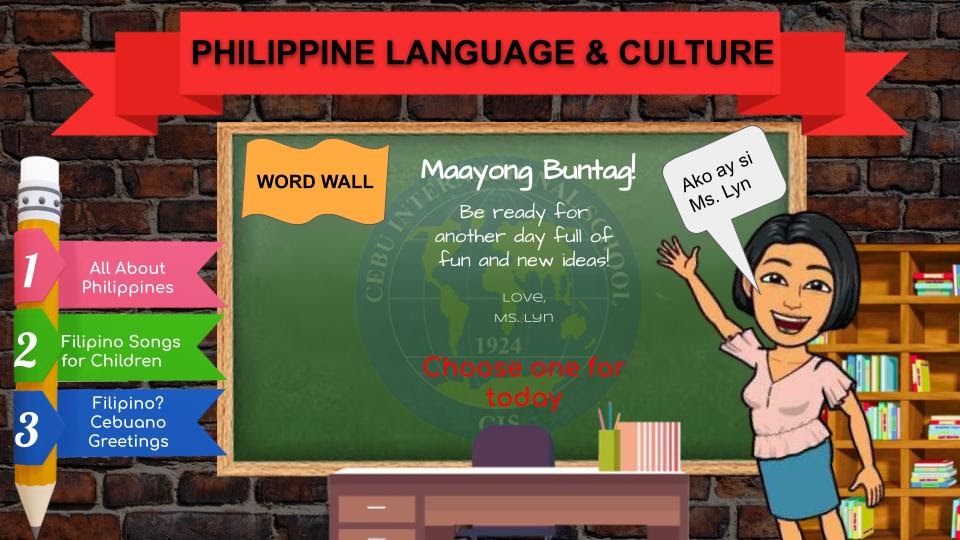
The Grade 2 and 3 students started their Philippine Language and Culture class by sharing how they use their whole body while listening. We talked about the different body parts in Cebuano and how we use them when listening (e.g., “mata” – to look at the person who’s talking, “kasing-kasing” – to care about what the person is saying, “ulo” – to think about what was being said). We then moved on to explore the Philippine Currency in connection to their Math topic on Place Value. We learned the words piso, diyes, singko, baynte, singkwenta, usa ka gatos, and usa ka libo. They also had a chance to create their own Philippine Play money.
In Grade 4s and 5s Philippine Language and Culture, we were learning the vocabulary related to expressing their feelings and emotions. They practiced saying “Nalipay ko, Naguol ko, Nabalaka ko, Nasuko ko, and Nakurat ko”. We then explored the entrepreneurial nature of the Filipino in the form of the Sari-Sari store and discovered what items a sari-sari store usually sells and why people buy them in connection with their unit on advertising.
The Kinder and Grade 1 students have been inquiring into the transdisciplinary theme of Who We Are – The way people live and work together can influence the well-being of a community. The past two weeks, has seen students inquiring about their social and emotional well-being, and this week they are focusing on how relationships with others affect well-being. We started our inquiry by doing a ‘Show and Tell’ and presented it through our synchronous class. The students were able to make connections right away when they were watching their friends’ show and tell. Some of the students even showed the same thing that they have! After the video call, the students reflected on these questions:
- What did you notice?
- What new connections did you make?
- How might you act with these new connections?
Students noticed they have similarities and they were surprised to discover all the connections they have with their classmates. When asked how they might act on the new connections they made, the students responded that they would like to talk more with their friends about these connections when they get back to school.
This week, the Early Years continued to inquire into the unit of inquiry – “Who We Are” by looking at our similarities and differences. We expanded our knowledge and shared that our names are a part of who we are as a person. We looked closely and compared the different letters found in our names. The Early Years noticed that our names have similar and different letters by recognizing letter names and sounds. We were also able to integrate numbers by counting the letters found in our names. In the following week, we will continue to learn together in our small groups and learn more about how our similarities and differences make us unique.
https://drive.google.com/file/d/1Il5vc1CU6LRaUhwh_BtGbxlavhQPhb1h/view?usp=sharing 
Middle and High School News
by Mr. Dale Wood, Middle and High School Principal
MYP class virtual displays
Grade 8 I&S Parent Coffee- explaining PEEAL essay model
Our Grade 8 Individuals and Societies students have been working on developing arguments into a formal paper. A few weeks ago we saw a useful tool in the Newsflash- the PEE model for writing strong paragraphs. In Grade 8 they have been examining an expanded version of this, the PEEAL essay structure (point-evidence-explain-analyse-link), which will be used extensively this year in this course and will also be used across various subjects within Grades 6-9. This simple model helps students to be aware of the quality of their own writing and evaluate the strength of the argument they are presenting.

Students worked on an example paragraph in class together in response to our research question:
What were the factors that led to humans changing from being hunters and gatherers to being farmers?
Over the weekend students were asked to complete a second paragraph independently using their research action plans to provide guidance. This was a formative piece of work; however, learning this structure will set students up for a successful year both in this course and in their other courses. The PEEAL structure helps students organise their thoughts and ideas more effectively to build more detailed, compelling, and convincing historical explanations and arguments. For this reason, this is a model which university students could also implement.
Mr. Denton held a parent workshop for parents of students in his I&S class two weeks ago to help them learn more about the PEEAL structure, and also learn how they might help their children at home. Please find included a link to the class website with videos about what each element of the structure looks like. https://sites.google.com/cis.edu.ph/g8-individuals/peeal

Middle High School Student Council
by Youngju K., 2020-21 StuCo President and Joo Ha C., Vice President
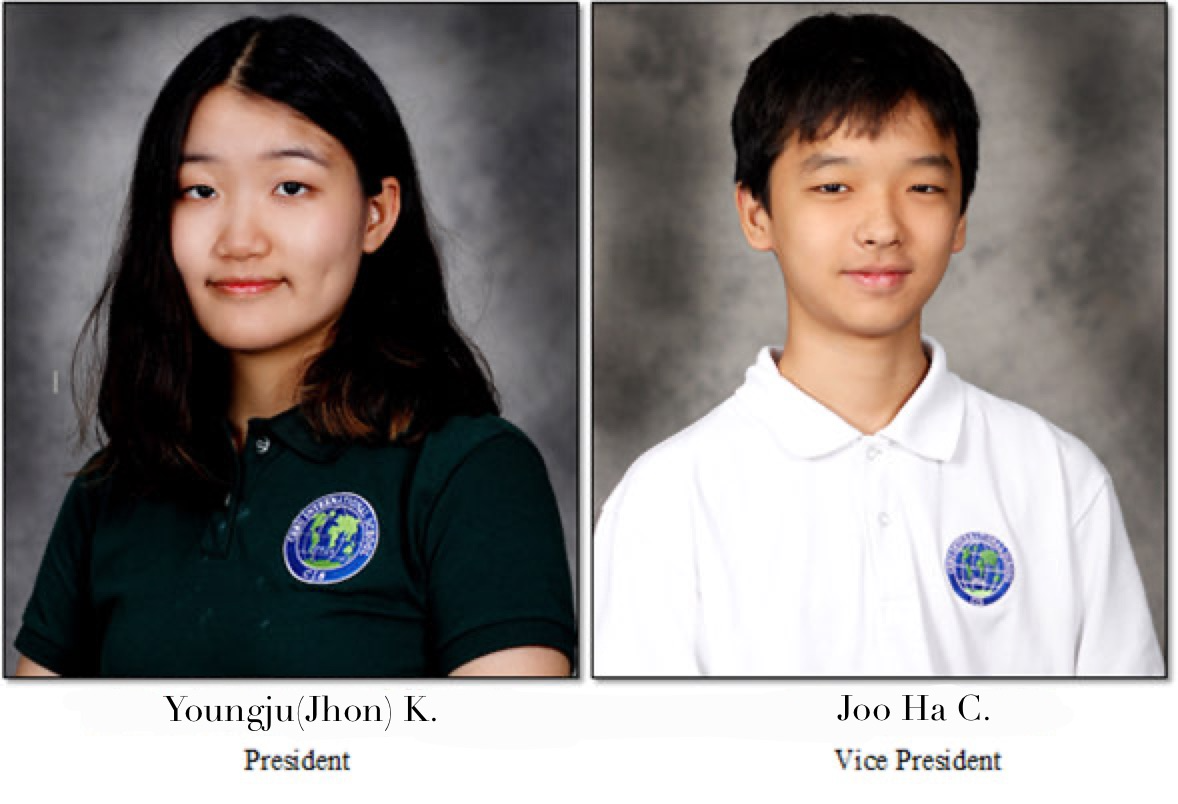 The first-ever virtual StuCo campaign has been an experience that both of us will never forget. Jhon and I were expecting, as has been the case in past years, to present in front of all of CIS. Instead, Covid-19 came along and we had to present our campaign virtually. It was quite a rapid process since our campaign videos had to be a maximum of 3 minutes and we were given about a week to create it. However, Jhon and I worked for hours, whether it was about our ideas, posters, or our videos. We knew it had to be perfect, and in the end, we felt it was all worth it.
The first-ever virtual StuCo campaign has been an experience that both of us will never forget. Jhon and I were expecting, as has been the case in past years, to present in front of all of CIS. Instead, Covid-19 came along and we had to present our campaign virtually. It was quite a rapid process since our campaign videos had to be a maximum of 3 minutes and we were given about a week to create it. However, Jhon and I worked for hours, whether it was about our ideas, posters, or our videos. We knew it had to be perfect, and in the end, we felt it was all worth it.
The elections started on August 20, during homeroom time. Ballots were sent out to each homeroom grades by the Student Council advisor and students were given the decision to vote for either Deandra as President and Dominic as Vice President or Jhon as President and Joo Ha as Vice President. This was the chance for the two teams to show what they would bring to CIS and both teams had definite strengths. After much consideration and voting, the school announced that the 2020-2021 Student Council President and Vice President would be Jhon Kim and Joo Ha Choi.
Our President, Jhon has been in CIS since grade 6, and has been a member of the Student Council for 3 years in a row. Joo Ha has been in CIS ever since pre-school and has been a member of the Student Council for 2 years. With their experience as class representatives, we can’t wait to see what they will do as the school’s President and Vice President.
For as long as we can remember we’ve always had only male house captains, but this year there is a refreshing change! Two of our elected house captains are female – Cassandra R. from grade 12 as Narra’s house captain and Jenny P. from grade 11 as Acacia’s house captain. We are looking forward to how this new gender ratio may open our eyes and help us raise our school spirit in new, creative ways.
Joo Ha and I can’t wait to plan and put into practice the various promises we made during our campaign presentation. We know that times are tough right now, but we hope to put in our best effort to help you guys with everything that is changing as we continue in this online learning set-up. Even though our spirits may be down due to current circumstances, we believe that it is our job to improve the morale of our student body! We want everyone to feel connected and included even in this period of physical isolation. Please don’t forget that we are here for you and that the teachers, your classmates, and friends, are all there to help you succeed. Do not hesitate to reach out for any type of help or aid.
Sincerely,
Your President and Vice President
Creativity Action Service (CAS)
by Kimberly C.
A Helping Hand from Home: Mask On
In the midst of the COVID-19 pandemic, it is in our best interest to protect ourselves and take good care of our health. Nevertheless, it is just as important to look out for the people around us. Working together is key in order for us to overcome the challenges we face during this time of crisis.
At CIS, we strive to be global citizens while taking action in our local community. Mask On is a student-led activity open for students from 7th to 12th grade and is spearheaded by Nayeli Caitlin Dy. Participants of this project will be making homemade masks that will be donated to Everlasting Hope, a non-government organization that helps children with cancer and their families.
Face masks are essential in the mitigation of the COVID-19 outbreak. Unfortunately, some people do not have the means to access them due to lack of supply or financial reasons. Hence, homemade face masks are a smart choice because they are reusable and easy to make. Moreover, a cloth mask is intended to trap droplets that are released when the wearer talks, coughs or sneezes. Asking everyone to wear cloth masks can help reduce the spread of the virus by people who have COVID-19 but don’t realize it (MAYO CLINIC, 2020).
Here are some useful information, which were obtained from a test conducted by scientists from the University of Chicago, about cloth face masks:
- Best fabric for cloth masks: When each fabric was used in a single layer, high thread count cotton performed the best with a filtration efficiency of around 80% for particles larger than 300 nanometers.
- Better when layered: One layer of cotton with two layers of silk, two layers of chiffon, or one layer of flannel was effective at filtering greater than 90% of particles larger than 300 nanometers.
- Keep the fit of the mask in mind: Improperly fitting masks which left gaps for leakage decreased filtration efficiency over 60 percent.
Tips:
- To check if the fabric serves as a great filter, hold the material up to light. Make sure you do not see the outline of the individual fibers.
- Wash cloth masks daily with soap or detergent and hot water.
Attached below are some preview materials of the Mask On initiative. Sign up now through the google form to join. We look forward to making masks together with you and for us to share them with the Everlasting Hope community.
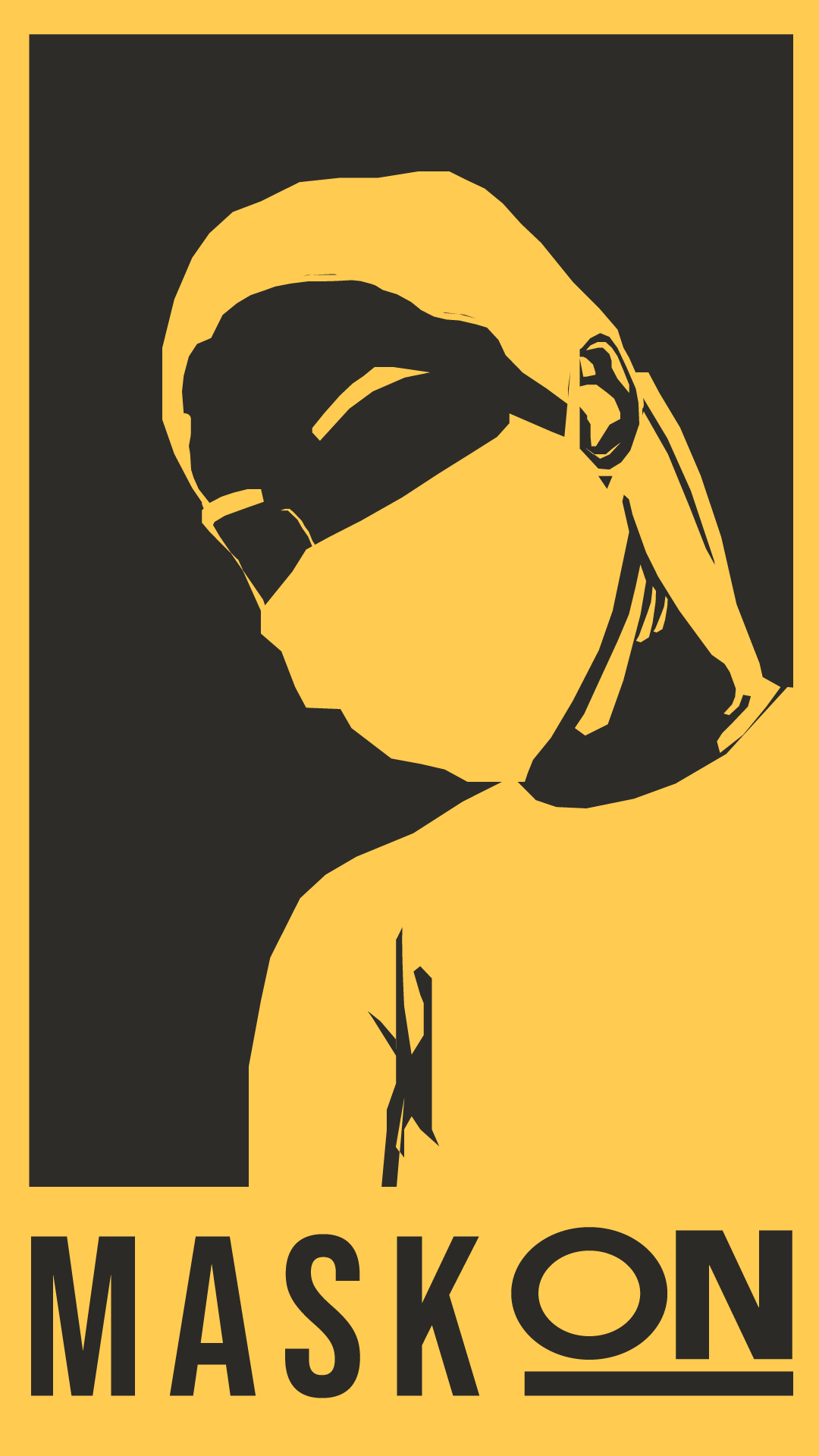
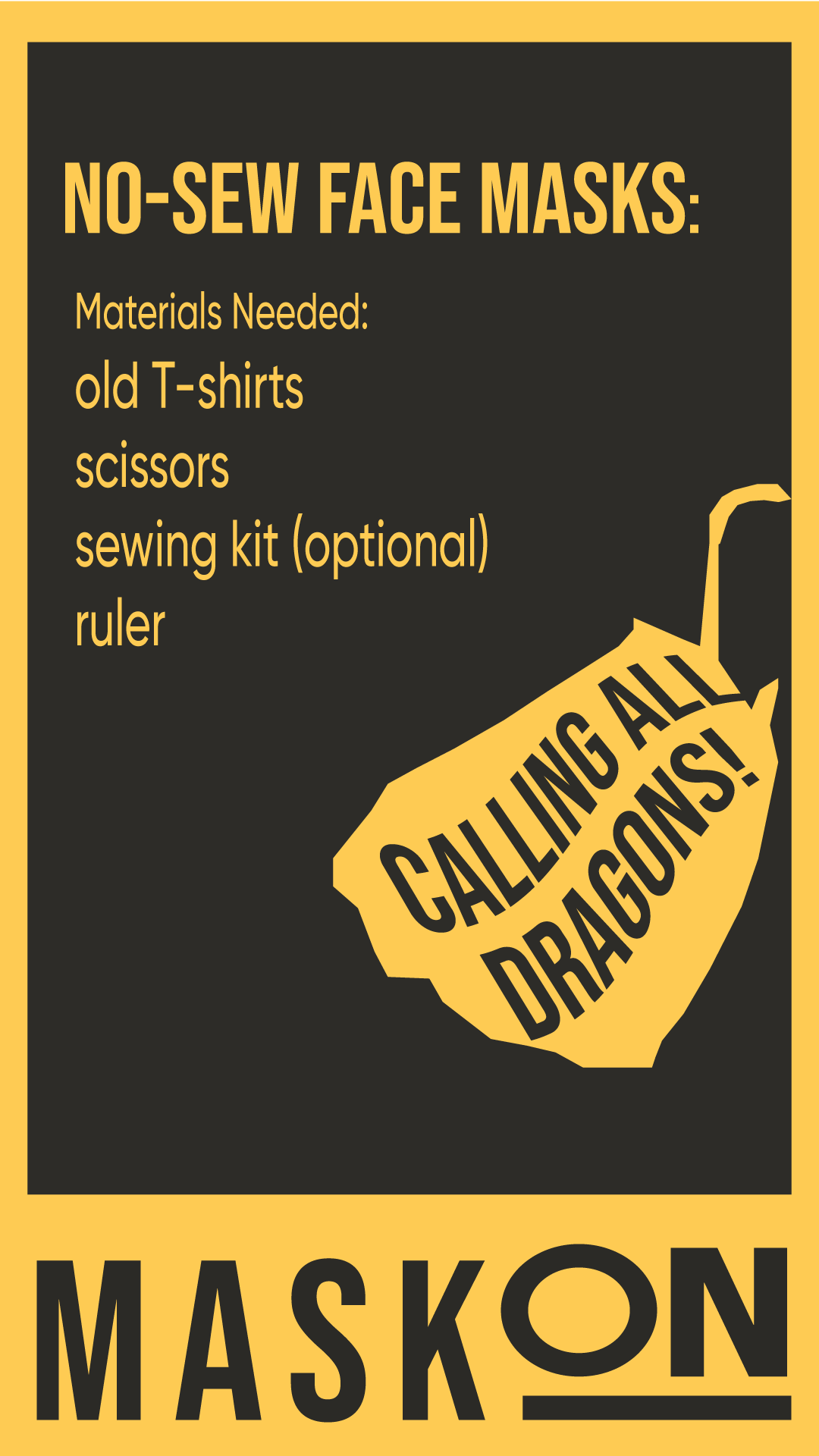
Service Learning
by Mr. Ace Pierra, Service Learning Coordinator
CIS Partners with Bayanihan Para sa Pilipinas
This year, we welcome a new partner called “ Bayanihan Para sa Pilipinas”. This group was formed to help the frontliners in the country. Here is their message;
“We would like to thank our partner school in Cebu, Cebu International School for helping us in distributing the care packs to our medical frontliners. Each package contains 10 items, including essentials such as germicidal soap, surgical masks, sanitizer, ear saver straps, coffee, muscovado, shampoo and conditioner.
This initiative is a wonderful opportunity for organisations to collaborate and give meaningful appreciation to our healthcare frontliners, who are the true heroes in this fight. Thank you Cebu International School and Uncle Arnulfo B. Pierra Jr. for teaming with Bayanihan Para Sa Pilipinas.
They will continue to accept donations such as medical supplies, care and food packs for our frontliners in Cebu.” – Emilio Garcia BPSP
College/Careers Counselor Corner
by Ms. Jenny Basa, College/Careers Counselor
Tip for the Week:
- When writing your resume/CV, start with the most recent activities or awards you have received. Universities will want to see the most current information about you.
- Identify your role in the activity or project.
- Write 2 or 3 sentences about each activity.
Upcoming Virtual Visits and Fairs:
DATE
September 5 – Saturday
9:00 – 10:30 AM
(online via zoom)
September 5 – Saturday
2:00 – 3:00 PM
(online via zoom)
September 10 – Thursday
1:30 – 2:30 PM
(online via zoom)
September 17 – Thursday
Available on these timezones:
04:00–07:00; 13:00–15:00 CEST (Central European Standard Time)
09:00–12:00; 18:00–20:00 ICT (Indochina Time)
7:00 – 10:00 PM PH Time (online via Zoom)
September 20
Sunday
10:00AM – 1:00 PM PH time
September 30
Wednesday
2:00 PM PH time
October 15
Thursday
1:00 PM
October 17-18
Saturday & Sunday
EVENT
Osaka University (Japan)
Virtual Open House for their International Undergraduate Degree Program in the Human Sciences
Click here to register: http://g30.hus.osaka-u.ac.jp/openday
Hiroshima University (Japan)
Session on International Global Studies
Click here to register: Zoom Session
https://us02web.zoom.us/j/87462397750?pwd=dGltaWViNlNPdHhhQkJ6TzFTMXk4Zz09
Meeting ID: 874 6239 7750
Passcode: 8t37er
University of British Columbia (Canada)
Zoom link to be sent via email by Ms. Basa
Session for CIS students
Council of International Schools Southeast Asia Fair
Link to Register: https://www.cois.org/for-students-and-parents/students/fairs-and-tours/southeast-asia
View the full list of attending universities (247 universities from all over the world)
KIC UnivAssist Webifair
Click here to register: https://southeastasia.webifairs.com/
Check this link for the list of 40 universities
Scholarships and Financial Aid
Overview of Financial Aid at Japanese national and private universities
To register, click here: https://japanuniconsortium.typeform.com/to/drhPRY
University of New Brunswick and University of Victoria (Canada)
https://us02web.zoom.us/j/3183943681
Meeting ID: 318 394 3681
The password will be 946466
Session for CIS students
EduCanda Virtual Fair
(list of institutions to follow)
SAT UPDATE:
Please note that most universities have gone test-optional. This means they do not require test scores for students to be eligible for admission.
*The College Board has restricted future registrations for Sept. 26 and Oct. 3 since these will likely be cancelled due to quarantine restrictions.
| 2020-2021 Test Dates | Test | Registration Deadline |
| *September 26, 2020 | SAT only (no Subject tests) | August 26, 2020 |
| *October 3, 2020 | SAT & SAT Subject Tests | September 4, 2020 |
| November 7, 2020 | SAT & SAT Subject Tests | October 7, 2020 |
| December 5, 2020 | SAT & SAT Subject Tests | November 5, 2020 |
| March 13, 2021 | SAT only (no Subject tests) | February 12, 2021 |
| May 8, 2021 | SAT & SAT Subject Tests | April 8, 2021 |
| June 5, 2021 | SAT & SAT Subject Tests | May 6, 2021 |
To register for the SAT, you may click on this link. If you need assistance or have any questions, please feel free to email Ms. Jenny Basa at jbasa@cis.edu.ph.





